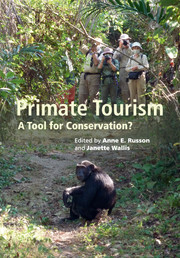Book contents
- Frontmatter
- Contents
- List of contributors
- Part I Introduction
- Part II Asian primates
- Part III African primates
- Part IV Neotropical primates
- 12 The impact of tourist group size and frequency on Neotropical primate behavior in Tambopata, Peru
- 13 Interactions between tourists and white-faced monkeys (Cebus capucinus) at Manuel Antonio National Park, Quepos, Costa Rica
- 14 Effects of tourism on Ecuadorian primates
- Part V Broader issues
- Part VI Conclusion
- Index
- References
14 - Effects of tourism on Ecuadorian primates
Is there a need for responsible primate tourism?
from Part IV - Neotropical primates
Published online by Cambridge University Press: 05 September 2014
- Frontmatter
- Contents
- List of contributors
- Part I Introduction
- Part II Asian primates
- Part III African primates
- Part IV Neotropical primates
- 12 The impact of tourist group size and frequency on Neotropical primate behavior in Tambopata, Peru
- 13 Interactions between tourists and white-faced monkeys (Cebus capucinus) at Manuel Antonio National Park, Quepos, Costa Rica
- 14 Effects of tourism on Ecuadorian primates
- Part V Broader issues
- Part VI Conclusion
- Index
- References
Summary
Introduction
Ecuador is one of the smallest and more biodiverse countries in the Neotropics (Ministerio del Ambiente et al., 2001; Mittermeier et al., 1997). The 20 primate species that inhabit forest remnants east and west of the Andes are important components of this diversity and are strongly affected by habitat loss, fragmentation, hunting, and illegal trade (de la Torre, 2010; Tirira, 2011). In the recent evaluation for the Red Data Book of Ecuadorian Mammals, 53% of the country’s 21 primate taxa (20 species, 21 subspecies) are considered threatened (19% vulnerable, 24% endangered, and 10% critically endangered), 42% are near threatened, and 5% are data deficient (Tirira, 2011) (see Table 14.1).
The deforestation rate in Ecuador, estimated at about 190 000 ha/year, is one of the highest in South America (Ministerio del Ambiente et al., 2001). It reflects the magnitude of the impact of habitat loss and fragmentation that Ecuadorian primate populations are facing. However, considering that the real geographic ranges of these species are not yet fully known, our understanding of the impacts of habitat loss and fragmentation on each of them is not as profound as it should be. The effects of hunting and illegal trade are even more difi cult to quantify, but add to the impacts of the two main habitat threats, explaining the alarming conservation status of primates in the country.
- Type
- Chapter
- Information
- Primate TourismA Tool for Conservation?, pp. 245 - 256Publisher: Cambridge University PressPrint publication year: 2014
References
- 1
- Cited by



